Your First 100 Clicks lead to your magic Conversion number
Last week Ginger discussed spending your first $1000 on digital ads, with the goal of getting both sales and information from that spend. This week, he’s focusing more on how to interpret some of the info you gather, specifically around what those clicks tell you about your “magic” conversion number. That conversion number isn’t really magic of course, but it may seem that way in how valuable it is in terms of giving you a very clear idea as to whether or not your ads are profitable or not. Figuring out your conversion number isn’t always straightforward, though, with some ad platforms making it more transparent than others. But if you know the best place and way to figure it out, you can then use that information elsewhere.
Last week, we discussed how you should spend your first $1,000 in advertising budget, and we mostly concentrated on Facebook as an advertising platform. That’s because many authors (although certainly not all) say they tend to get a better return on investment when advertising on Facebook.
But there is one thing that Advertising on Amazon can provide for authors that no other advertising platform can – and that’s why it should definitely not be ignored, even for authors just dipping their toe into advertising for the first time.
What Advertising on Amazon can do which no other platform can is provide an unbroken thread of information about how far readers and potential readers got in the buying process – from the moment they first saw one of your advertisements (this is called an Impression) to the moment they actually clicked “Buy Now” (this is what ecommerce experts call a Conversion, or what Amazon defines as an Order.)
On Facebook, assuming you’re using a traffic ad to drive potential buyers to your book’s product page on Amazon, you don’t get all of this information. Facebook will tell you how many Impressions your ads get, and how many people Click on them – but after that, you get radio silence.
That’s because Amazon and Facebook don’t share any information – so you’ll never know for certain how many of those Facebook Clicks “convert” into Amazon sales. You can make an educated guess – and that’s what we discussed last week – but you’ll never know for sure.
With the Advertising on Amazon dashboard, though, the thread of information is unbroken. How many Impressions resulted in a Click, and then how many of those Clicks converted into an Order. This is invaluable information because it ultimately tells you how ‘buyable’ your book is.
And ultimately, that’s what it’s all about – advertising a book people actually want to buy. Now, obviously, not everybody who clicks on your ad will buy your book – but the higher the percentage of people who do, the easier it is to make money, and Amazon is the quickest and easiest way to find that out.
Facebook versus Amazon
The advantage of Facebook is that it makes advertising easy. You create your ad graphic, you write your copy, and you point it directly at your Product Page on Amazon. You can pick an audience based on Interests, and dial that audience in by pairing multiple Interests together (for example, fans of Stephen King books who also own a Kindle.)
Advertising on Amazon is a lot more complex. You don’t target people using Amazon, but rather target books that these people might be looking at. Your ads show up either in the search results people are looking for, or in the ribbon of ads known as “Products Related to This Item…”
(You can spot what’s advertising on Amazon easily, because it has a tiny “Sponsored” disclaimer beneath the header.)

This opens up all sorts of complexities as you pick between advertising using keywords, or having your ads show up on the product pages of other products – there’s a very steep learning curve, and a lot of science behind dialing in your advertising to make it profitable.
But, at the end of the day, the success or failure of your advertising comes down to how many people Click on those adverts and then Order your book; and when you first start advertising it’s worth investing some money to get an idea of roughly what that percentage is. The quickest and most effective way to do that is to buy 100 Clicks on Advertising on Amazon, and examine the results.
Your first 100 Clicks
I chose 100 Clicks because when you’re working out your conversion rate, you normally do so as a percentage. This is industry standard, so we might as well stick with it. If you buy 100 Clicks using Advertising on Amazon, that will give you a literal percentage of how many of those Clicks “converted” into a sale.
At this point, that’s the most important figure we need to identify, so don’t worry about making a profit with this advertising – that comes later. As management consultant and author Peter Drucker famously said: “You can’t improve what you can’t measure.”
The quickest and easiest way to ‘buy’ 100 Clicks using Advertising on Amazon is with automated and automatically targeted ads – something I never used to advise, but which have become much more effective over recent months. The advantage of using automated ads rather than picking and choosing keywords yourself at first is that you’re more likely to get impressions and (hopefully) clicks this way. Unlike Facebook, it can sometimes be difficult to get Amazon to spend your daily budget when you have used hand-picked keywords and comparable products to target your ads, whereas Amazon’s automated ads tend to deliver more quickly and easily.
Amazon will probably recommend a figure to set as your default Bid and you should initially go with it – the targeted products and keywords, and more strategic bidding, comes later. At the moment your goal is for Amazon to get you 100 Clicks as quickly as possible with targeted advertising that’s as smart as their algorithm can come up with.
Then, you just sit back and wait.
How long you wait depends on what kind of book you’re trying to sell, and how effective your advertising is – by which I mean how many people look at your book cover and click on it to be taken to your product page. If you’re finding you get lots of Impressions but very few Clicks (anything below 0.01% CTR or Click Thru Rate) then you can probably bet that your cover and title need to be improved.
Once you’ve got 100 Clicks, though, it’s time to work out how many of those converted into Orders, and that will give you the information you need to start the hard working of improving that figure.
Now, be forewarned – this process isn’t necessarily cheap. If you’re bidding $0.75 to $1.00 per bid, you might have to burn through $100 in advertising before you get that magical figure – and you might not like the result when you do! But it’s a very important benchmark to set, and one which will dictate a lot of the subsequent choices you make.
So, I’ve got 100 Clicks – now what?
Assuming you’ve got 100 Clicks, you’ll also have your conversion rate – the percentage at which those Clicks “convert” into Orders (Orders / Clicks). This will show you roughly how ‘buyable’ your book is.
Now, don’t get too despondent if this percentage isn’t huge. Remember that the folks advertising products on Google Adwords figure a good conversion percentage is between 2.5% and 3% – so they think if just 3 out of the 100 people who click on their ads end up buying their product, they’re doing great!
But when you’re spending pennies per Click and offering products that cost tens or even hundreds of dollars, you can see how it’s much easier for them to make a profit with that tiny conversion percentage.
Self-published authors tend to work with much leaner margins, though. I retail my ebooks at $4.99 for example, so I only make $3.49 in profit for each book I sell. At a 3% conversion rate, that means I’d have to be spending $0.10 or less per Click to be breaking even!
But by knowing your Conversion percentage, you can at least figure that out! It’s a powerful piece of information to have, and one that can then guide you on your next moves as you try to make your advertising profitable.
If your Conversion percentage is low or even zero, don’t panic. However, this demonstrates that something about your Product Page on Amazon is stopping potential readers from buying your book. They clicked on your ad – that’s a good sign – but they didn’t commit to clicking “Buy Now”. This is where you need to get a little introspective and start examining your blurb, Look-Inside, and other product page details to try and improve how ‘buyable’ your book is.
I mentioned last week that I managed to double my Conversion rate by changing the font size of my blurb, and then double it again by re-writing the first few pages of my novel (the part you see in the Look Inside.) If you’re not getting any Orders after getting 100 Clicks, you should try something similar.
(The downside is that you’ll have to make those changes and then invest in buying 100 additional Clicks to see if it made any difference to your Conversion percentage.)
Ideally, though, you’ll have got some Orders. Not enough to make your advertising profitable (yet) but enough to confirm that if you show your book to enough people, some of them will buy it. This is a big deal! Having a book people actually want to buy is perhaps the most important step towards becoming a successful self-published author.
Having achieved that much, at least, you can start turning your attention to advertising profitably.
How to advertise profitably
Once you’ve discovered your Conversion percentage, the hard work begins – learning how to use that information to help you spend less on advertising than you make in royalties. Making advertising profitable is what will make or break your career as a self-published author and it all starts there.
For some people, it’s easy. My books, for example, sell about 1 copy for every 12 clicks – a non-mind-blowing conversion percentage of around 8%. With a retail price of $4.99, that means I need to spend $0.29 or less per click on my advertising in order to make a profit.
For that, I turn to Facebook. Assuming my Conversion percentage remains the same (and that is an assumption – I’ll get to that shortly) I know that I should be making a profit if my Facebook ads generate Clicks for less than $0.29 each. This is pretty easy to achieve for even newbie advertisers.
When I’m using Advertising on Amazon, however, $0.29 is not a super competitive bid – so I have to tailor my Campaigns appropriately. Fortunately, this is where the complexities of Amazon can assist you. We generated that initial Conversion percentage using automated ads. When you start developing lists of keywords and lists of products to have your ad show up alongside, you can target your advertising much more effectively and hopefully make that percentage higher and higher.
Amazon’s automated ads might show my books alongside all kinds of Romantic Suspense books, for example – but I know if I target Motorcycle Club Romance books then I’m more likely to find my ideal readers, and that 12-to-1 conversion ratio might tighten dramatically. Likewise, excluding some categories might help me get lower-cost clicks, or a higher percentage of conversions.
This is where the true complexity of Advertising on Amazon comes into play, and that’s a topic we’ve covered elsewhere. Just know that your first 100 Clicks are just that – the first – and the more you tweak and optimize your campaigns, the closer and closer you’ll get to turning a profit with them.
And ultimately, that’s the goal. If it’s even by just a single penny, the moment you spend less on advertising than you make in royalties, you’ve opened up a whole new world of opportunity for yourself. Advertising self-published books is a highly competitive, low-margin business to be in – but there are thousands of authors finding success with it, and the only thing stopping you from becoming one of them is spending the time and putting in the effort to make that advertising work.
It all starts with your first 100 Clicks – but it certainly doesn’t end there!











